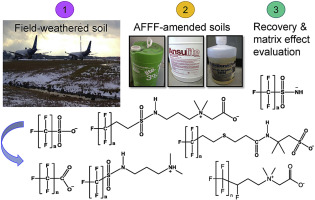当前位置:
X-MOL 学术
›
Anal. Chim. Acta
›
论文详情
Our official English website, www.x-mol.net, welcomes your
feedback! (Note: you will need to create a separate account there.)
Optimization of extraction methods for comprehensive profiling of perfluoroalkyl and polyfluoroalkyl substances in firefighting foam impacted soils
Analytica Chimica Acta ( IF 5.7 ) Pub Date : 2018-11-01 , DOI: 10.1016/j.aca.2018.06.046 Gabriel Munoz , Prisca Ray , Sandra Mejia-Avendaño , Sung Vo Duy , Dat Tien Do , Jinxia Liu , Sébastien Sauvé
Analytica Chimica Acta ( IF 5.7 ) Pub Date : 2018-11-01 , DOI: 10.1016/j.aca.2018.06.046 Gabriel Munoz , Prisca Ray , Sandra Mejia-Avendaño , Sung Vo Duy , Dat Tien Do , Jinxia Liu , Sébastien Sauvé

|
The comprehensive analysis of aqueous film forming foam (AFFF) formulations has led in recent years to the discovery of novel classes of perfluoroalkyl and polyfluoroalkyl substances (PFASs). Whether the pre-existing analytical methods for historically monitored PFASs, including perfluorooctane sulfonate (PFOS), could be transferable to a large breadth of newly identified PFASs remains, however, an open question. Data from various lines of evidence indicate that current extraction procedures previously validated with anionic and neutral PFASs may seriously underperform for many cationic and zwitterionic PFASs. The extraction efficiency and instrumental response could be strongly matrix-dependent, which may preclude a robust analysis. The present study sought to investigate a suitable sample preparation procedure for the analysis of anionic, cationic, and zwitterionic PFASs in soil samples. In total, 86 PFASs, representing 24 chemical classes previously discovered in AFFF formulations or at AFFF-impacted sites, were evaluated. The merits and limitations of various extraction media were examined using an AFFF-impacted field-weathered loam soil, as well as a background loam soil amended with AFFFs in-house. Methanol with hydrochloric acid provided excellent recoveries for most cationic and zwitterionic PFASs, including fluorotelomer sulfonamidoalkyl betaines (e.g., 6:2 FTAB) and fluorotelomer betaines (e.g., 9:1:2 FTB), yet performed less satisfactorily for certain anionic PFASs, and may also cause conversion of some PFASs. Sequential extractions using methanol with ammonium acetate exhibited limited matrix effects and suitable recoveries of PFASs from soils of diverse textural classes and organic matter content. The newly-developed extraction method presented the best option for future in-depth characterization of PFASs at AFFF-impacted sites.
中文翻译:

消防泡沫影响土壤中全氟烷基和多氟烷基物质综合分析的提取方法优化
近年来,对水性成膜泡沫 (AFFF) 配方的综合分析导致发现了新型全氟烷基和多氟烷基物质 (PFAS)。然而,包括全氟辛烷磺酸 (PFOS) 在内的历史监测 PFAS 的现有分析方法是否可以转移到大量新发现的 PFAS 中,仍然是一个悬而未决的问题。来自各种证据的数据表明,先前使用阴离子和中性 PFAS 验证的当前提取程序可能严重低于许多阳离子和两性离子 PFAS。提取效率和仪器响应可能强烈依赖于基质,这可能会妨碍进行稳健的分析。本研究旨在研究一种合适的样品制备程序,用于分析阴离子、土壤样品中的阳离子和两性离子 PFAS。总共评估了 86 种全氟和多氟烷基物质,代表先前在 AFFF 配方中或在受 AFFF 影响的地点发现的 24 个化学类别。使用受 AFFF 影响的田间风化壤土以及内部用 AFFF 修正的背景壤土,研究了各种提取介质的优点和局限性。甲醇和盐酸为大多数阳离子和两性离子 PFAS 提供了出色的回收率,包括含氟调聚物磺酰氨基烷基甜菜碱(例如,6:2 FTAB)和含氟调聚物甜菜碱(例如,9:1:2 FTB),但对某些阴离子 PFAS 的表现不太令人满意,并且也可能导致某些 PFAS 的转化。使用甲醇和醋酸铵进行顺序提取显示出有限的基质效应和从不同质地类别和有机质含量的土壤中回收 PFAS 的合适回收率。新开发的提取方法为未来在受 AFFF 影响的地点深入表征全氟和多氟烷基物质提供了最佳选择。
更新日期:2018-11-01
中文翻译:

消防泡沫影响土壤中全氟烷基和多氟烷基物质综合分析的提取方法优化
近年来,对水性成膜泡沫 (AFFF) 配方的综合分析导致发现了新型全氟烷基和多氟烷基物质 (PFAS)。然而,包括全氟辛烷磺酸 (PFOS) 在内的历史监测 PFAS 的现有分析方法是否可以转移到大量新发现的 PFAS 中,仍然是一个悬而未决的问题。来自各种证据的数据表明,先前使用阴离子和中性 PFAS 验证的当前提取程序可能严重低于许多阳离子和两性离子 PFAS。提取效率和仪器响应可能强烈依赖于基质,这可能会妨碍进行稳健的分析。本研究旨在研究一种合适的样品制备程序,用于分析阴离子、土壤样品中的阳离子和两性离子 PFAS。总共评估了 86 种全氟和多氟烷基物质,代表先前在 AFFF 配方中或在受 AFFF 影响的地点发现的 24 个化学类别。使用受 AFFF 影响的田间风化壤土以及内部用 AFFF 修正的背景壤土,研究了各种提取介质的优点和局限性。甲醇和盐酸为大多数阳离子和两性离子 PFAS 提供了出色的回收率,包括含氟调聚物磺酰氨基烷基甜菜碱(例如,6:2 FTAB)和含氟调聚物甜菜碱(例如,9:1:2 FTB),但对某些阴离子 PFAS 的表现不太令人满意,并且也可能导致某些 PFAS 的转化。使用甲醇和醋酸铵进行顺序提取显示出有限的基质效应和从不同质地类别和有机质含量的土壤中回收 PFAS 的合适回收率。新开发的提取方法为未来在受 AFFF 影响的地点深入表征全氟和多氟烷基物质提供了最佳选择。











































 京公网安备 11010802027423号
京公网安备 11010802027423号